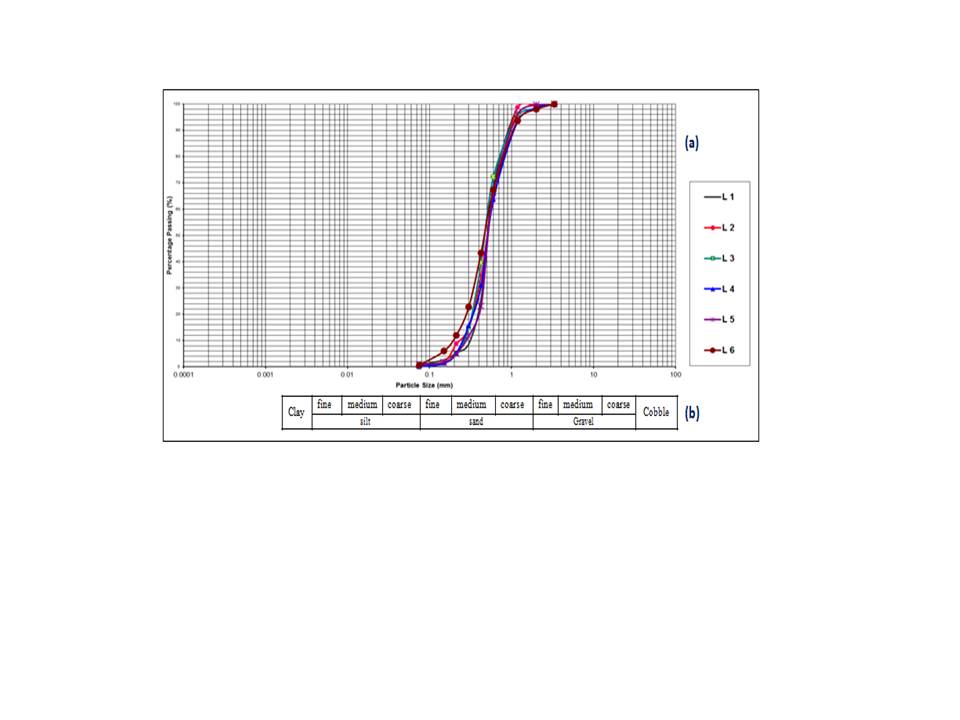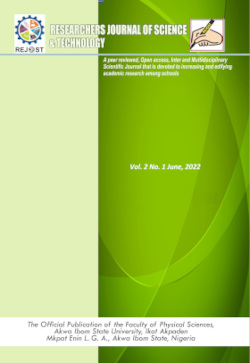Textural Characteristics of subsoils in the main campus of Akwa Ibom State University, Ikot Akpaden, Akwa Ibom State, Southern Nigeria
Keywords:
Textural properties, Shallow subsoils, Subsurface stratification, Compaction, Soil improvementAbstract
The textural characteristics of soils are very useful indices of the potential mechanical behaviour of the soil. These properties are used to identify and classify soils, prior to construction. Soils in nature usually contain varying proportions of gravel, sand, silt, clay or organic matter, they rarely exist separately. The aim of this study is to evaluate the textural properties of shallow subsurface soils, in six different locations within the main campus of Akwa Ibom State University, which serve as foundations for office buildings and roads. Field investigations including the drilling of six geotechnical boreholes to a depth of three maters each and laboratory analysis of the Moisture content, Particle size distribution, Atterberg limit and Compaction properties of the disturbed soil samples were performed. The stratification of Sub soils from 0-3 meters in the six locations in the main campus of the University consist of reddish brown, clayey, silty, fine to medium grained sand in locations L1, L2 and L3, while a light to dark brown, clayey, silty, fine to medium grained sand underlies locations L4, L5 and L6. Laboratory analysis of the sub soils reveal low natural moisture content percentages of the soils which are generally below 30%. The clay have average liquid limit and plasticity index values between 34% to 50% and 16% to 25% respectively and are of low to intermediate plasticity with a low swelling potential. Particle size distribution of the soils, show they are poorly gradedsand. Optimum moisture content and maximum dry density values of the soil show location 4 has the lowest percentage of fines (40%), the lowest optimum moisture (8.3%) and highest maximum dry density (1830 kg/m3), while location 5 has the highest percentage of fines (48%) the highest optimum moisture content (11.8%) and lowest maximum dry density (1740kg/m3).The maximum dry density values and optimum moisture content percentages of the soils in all locations fall within the recommended range for good back fill materials. Although the textural properties of the subsoils show that the soils are all suitable for construction purposes, an increase in the density of the soils is recommended to improve its stability, using a suitable soil improvement method.
References
Akpokodje, E. G. (2001). Introduction to Engineering Geology. Pam Unique Publishing Co. Ltd. Port Harcourt. 53.
American Society for Testing and Materials (1975). Special Procedures for Testing Soil and Rocks for Engineering Purposes.Technical Publication, No. 479, 5th edition.
Avwenegha, E.O., Akpokodje, E. G and Tse, A. C. (2014).Geotechnical properties of subsoils in Warri, western Niger delta, Nigeria.Journal of Earth Sciences and Geotechnical Engineering. 4 (1), 89-102.
British Standard Methods of Test for soils for Civil Engineering Purposes. B.S 1377: Part 2. Published by the British Standards Institution 8-200.
Ehibor, I. U., Akpokodje, E. G and Tse, A. C. (2019). Geotechnical Properties of Clay soils in Uyo Town, eastern Niger delta, Nigeria. International Organization of Scientific Research (IOSR), Journal of Applied Geology and Geophysics. 7 (3) 8-16.
Etu- Efeotor, J. O (1997). Fundamental of petroleum Geology. Paragraphics, Port Harcourt. 110-111 and 116-135.
Murthy, V.N.S (2009). Textbook of Soil Mechanics and Foundation Engineering. Geotechnical Engineering Series.CBS Publishers & Distributors, New Delhi. Bangalore. 59 & 116.
Nwankwoala, H. O., Amadi, A. N., Ushie, F. A andWarmate, T. (2015). Preliminary determination of subsurface soil profiles in Akenfa community, Bayelsa state, Nigeria. Civic and Environmental Research.7 (8), 125-131.
Pettijohn, F. J (2004). Sedimentary Rocks Third Edition.CBS Publishers & Distributors, New Delhi (India) 24.
Peters, S. W. (1989). Geology of AkwaIbom state in AkwaIbom state- Physical backgrounds, soils, land use and ecological problems.83-140.
Short, K. C and Stauble, A, J (1967). Outline of the Geology of the Niger delta. American Association of Petroleum Geologists. 56. 761-799 and 1795-1983.
Tse, A. C and Akpokodje, E. G. (2010). Subsurface soil profiles in site investigation for foundation purposes in parts of the mangrove swamps of the eastern Niger delta. Journal of Mining and Geology. 46 (1), 79-91.
Ugbe, F. C. (2011). Basic engineering geological properties of lateritic soil from western Niger delta.Research Journal of Environmental and Earth Sciences. 3 (5) 571-577
Ugbe, F.C. (2012). Predicting Compaction Characteristics of lateritic soils of Western Niger delta, Nigeria.Research Journal of Environmental and Earth Sciences. 4 (5) 553-559

Downloads
Published
How to Cite
Issue
Section
License
Copyright (c) 2023 Researchers Journal of Science and Technology

This work is licensed under a Creative Commons Attribution-NonCommercial-NoDerivatives 4.0 International License.




